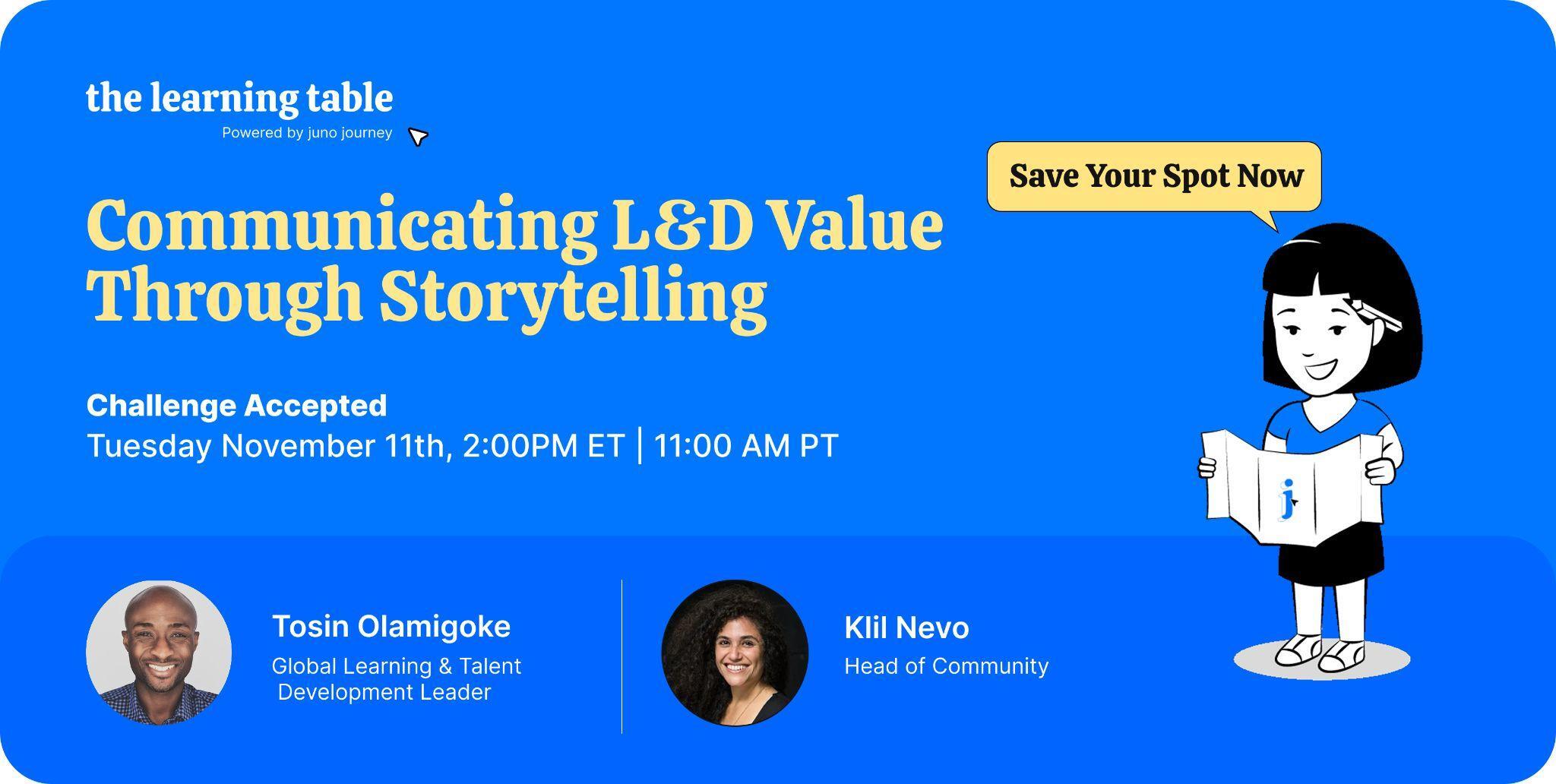
ICYMI: Challenge Accepted #6 - Communicating L&D Value Through Storytelling
ICYMI: Communicating L&D Value Through Storytelling
Challenge Accepted #6 with Tosin Olamigoke
November 11, 2025 | Hosted by The Learning Table & Juno Journey
Our latest Challenge Accepted session brought together L&D leaders from across the community for a powerful conversation with Tosin Olamigoke, Senior Learning & Talent Partner at Acorns, on one of the toughest challenges in the field:
“How do we communicate L&D’s impact in a way the business actually cares about?”
As Tosin put it, most L&D teams aren’t short on results — they’re short on stories that help those results resonate. This session was about bridging that gap: transforming data, anecdotes, and outcomes into narratives that connect learning to business growth.
Turning Learning into Stories That Stick
Tosin reminded us that storytelling isn’t window dressing — it’s how you make learning matter to the business. The goal is to connect programs to outcomes in a way that leaders can see, feel, and act on.
Start with the Audience, Not the Slides
Storytelling starts with understanding who you’re speaking to. If you want the story to land, speak their language — the metrics and moments they care about.
- CEO: learning as a growth multiplier
- CFO: learning as an investment (not a cost)
- CRO/Sales: learning as a revenue driver
- CTO/Engineering: learning as the fuel for AI adoption & productivity
- People Managers: learning as the key to engagement & retention
“If you want the story to land, you have to talk in the metrics and moments they care about.”
Frameworks That Make Stories Stick
Three simple, repeatable frameworks you can use immediately:
- Before → After → Impact → Sustainability (best for executives)
Paint the transformation, not just the numbers. - Problem → Tension → Resolution → Impact (great for managers & peers)
Show the human side and the emotional payoff. - Human → Behavior → Business → Growth (perfect for all-hands)
Start with one person’s story and scale up to org impact.
“The story doesn’t always have to come from you. Let your learners and leaders tell it in their own words. That’s when it becomes real.”
Hook with Curiosity. Close with Impact.
To capture attention, open with surprise, emotion, or curiosity:
- “We discovered something we didn’t expect…”
- “Let me tell you about one frontline manager who…”
- “What we learned changed how we think about performance.”
Then close the loop with a single, clear business tie-in:
“That’s why this program made such a strong impact on our growth and retention.”
It’s not about more data — it’s about data that means something.
When You Don’t Have Perfect ROI Data
You don’t need a perfect dashboard to tell a credible story. Use proxy metrics and qualitative signals to paint the picture:
- Faster onboarding and reduced rework
- Improved survey comments and peer mentoring
- Retention of top performers
- Anecdotes from leaders or even customers
“Small data plus a human story is still powerful data. It’s about connecting the dots, not counting them.”
What the Community Asked — and What We Learned Together
- How do we tell compelling stories when leadership only wants numbers?
Blend emotion and evidence: lead with the human moment, close with the metric — even if it’s a small win. - What if our data isn’t impressive yet?
Focus on trajectory. A 10% improvement framed as part of a larger journey is more credible than chasing vanity numbers. - How do we make stories scalable across regions and departments?
Create playbooks and templates; collect quarterly quotes and compile a mini “impact digest” for leadership. - How do we inspire managers to tell these stories themselves?
Recognize and reward storytellers publicly. Storytelling spreads when it’s celebrated.
The shared insight: storytelling isn’t just a comms tactic — it’s a culture shift that turns L&D from a service provider into a business partner.
Your Challenge This Week
What story can you tell this week to show the impact of your work?
Maybe it’s a manager who finally felt equipped to coach. A team that shaved hours off meetings with better collaboration habits. Whatever it is — tell it in the language your audience understands.
Because when learning has a story, it also has a seat at the table.
🧠 The Challenge Accepted series brings together L&D and Enablement leaders to tackle the biggest challenges in the field — one real conversation at a time. Stay tuned for our next session, and join the community at The Learning Table.